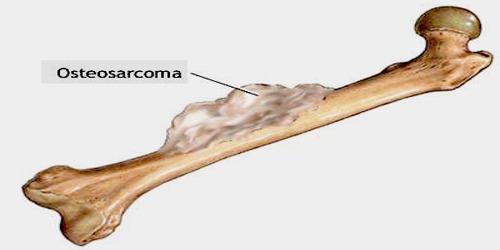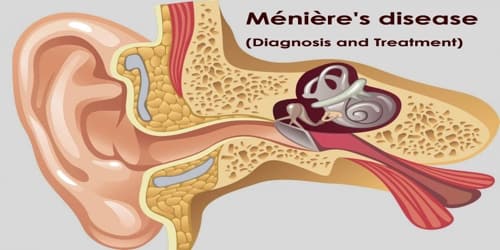Osteosarcoma
Definition
Osteosarcoma is a cancerous tumor that grows in a bone, and sometimes it can start in the bone and move to other parts of the body. Specifically, it is an aggressive malignant neoplasm that arises from primitive transformed cells of mesenchymal origin (and thus a sarcoma) and that exhibits osteoblastic differentiation and produces malignant osteoid. It is the most common kind of bone cancer in children and teens. It can affect adults, too, but teenage boys are most likely to get it.
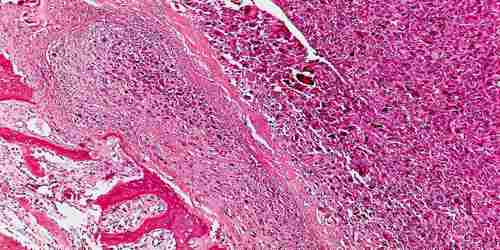
It is the most common type of cancer that develops in the bones. These tumors often stem from osteoblasts, which are cells responsible for the formation of new bone. This type of tumor is most prominent around the knee or around the edges of any long bone in the body and tends to affect teenagers and children.
The treatment for osteosarcoma is chemotherapy and surgery to remove the tumor is usually successful when the disease is diagnosed early on, before it can spread.

Causes, Sign and Symptoms of Osterosarcoma
The exact cause of osteosarcomas developing is not yet known; however, a number of risk factors have been identified. Several research groups are investigating cancer stem cells and their potential to cause tumors along with genes and proteins causative in different phenotypes. Radiotherapy for unrelated conditions may be a rare cause.
- Familial cases where the deletion of chromosome 13q14 inactivates the retinoblastoma gene is associated with a high risk of osteosarcoma development.
- Bone dysplasias, including Paget’s disease of bone, fibrous dysplasia, enchondromatosis, and hereditary multiple exostoses, increase the risk of osteosarcoma.
- Li–Fraumeni syndrome (germline TP53 mutation) is a predisposing factor for osteosarcoma development.
- Rothmund–Thomson syndrome (i.e. autosomal recessive association of congenital bone defects, hair and skin dysplasias, hypogonadism, and cataracts) is associated with increased risk of this disease.
- Large doses of Sr-90 emission from nuclear reactor, nicknamed bone seeker increases the risk of bone cancer and leukemia in animals, and is presumed to do so in people.
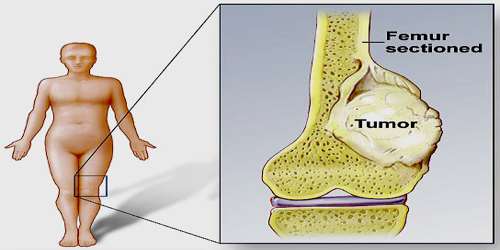
Teenagers who are having a “growth spurt” are most likely to get it, and taller kids may be more at risk. There may also be a link between the speed of the growth spurt and tumor development, but scientists are still studying this.
This type of cancer is usually diagnosed as a result of the patient seeking help for the symptoms. The knee or shoulder areas are most often affected, and osteosarcomas cause pain and swelling in the affected area. In fact, pain and swelling are the most common symptoms. Unfortunately, pain and swelling are common ‘growing pains’ in kids, often delaying identification of the osteosarcoma. With some types of osteosarcomas, bones can weaken and then break, though actual breaks are relatively rare. Additional symptoms come as secondary side effects as a result of treatment options or outcomes. As with any serious surgery (or cancer treatment), there are emotional side effects that have lasting effects on patients, as often their life changes considerably.
In cases of more deep-seated tumors that are not as close to the skin, such as those originating in the pelvis, localised swelling may not be apparent.
Diagnosis and Treatment of Osterosarcoma
An x-ray is often the first diagnostic test that osteosarcoma patients receive, and an experienced radiologist may recognize immediately that bone cancer is the likely diagnosis. There are several additional tests that are a critical part of osteosarcoma diagnosis and staging:
- An MRI of the entire bone where the primary tumor is located. This test can rule out “skip metastases” (spread of the tumor to other areas of the bone).
- A chest x-ray and CT scan of the chest to detect lung metastases
- A bone scan of the body to rule out distant spread of the disease
- A biopsy of the tumor, which provides a definite diagnosis based on the characteristics of tumor tissue seen under a microscope. The biopsy will also show whether the tumor is high grade (highly malignant, which is the case for most osteosarcomas) or low grade.
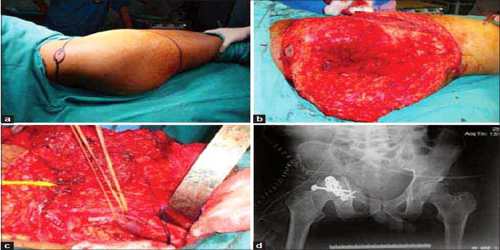
A complete radical, surgical, en bloc resection of the cancer is the treatment of choice in osteosarcoma. Although about 90% of patients are able to have limb-salvage surgery, complications, particularly infection, prosthetic loosening and non-union, or local tumor recurrence may cause the need for further surgery or amputation.
Mifamurtide is used after a patient has had surgery to remove the tumor and together with chemotherapy to kill remaining cancer cells to reduce the risk of cancer recurrence. Also, the option to have rotationplasty after the tumor is taken out exists.
Though radiation therapy is not widely used in osteosarcoma treatment, it can be effective and is occasionally recommended, especially when a tumor is difficult to remove surgically or when residual tumor cells remain after surgery.
Reference:
